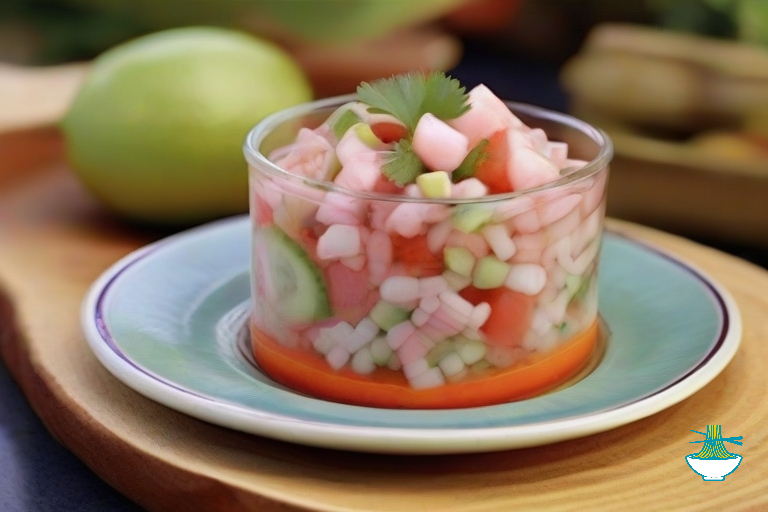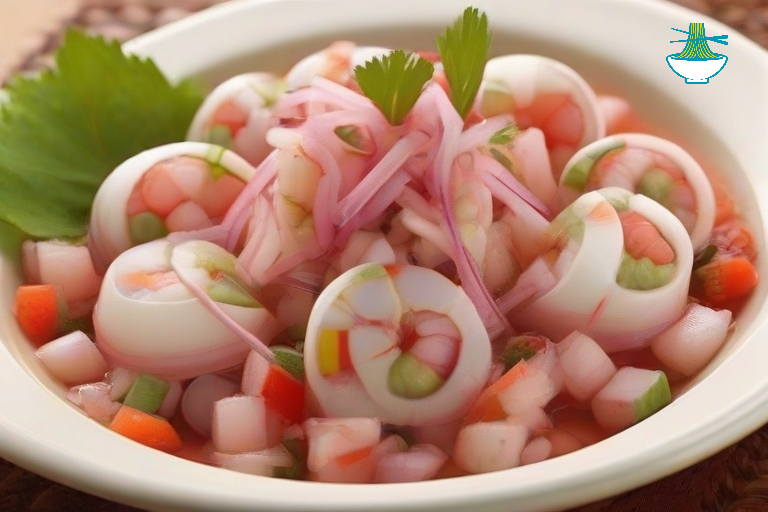Nestled in the heart of the Caribbean, Aruba is a paradise of azure waters and vibrant culinary traditions. Among its culinary gems, Aruban Ceviche shines as a refreshing celebration of the sea, blending the freshest seafood with tropical fruits and aromatic spices. This recipe not only tantalizes the taste buds but also offers a bounty of health benefits, rich in essential vitamins like Vitamin C and Omega-3 fatty acids that boost nutrition, immunity, and heart health. However, as with any seafood dish, moderation is key to avoid excessive sodium intake. Dive into the vibrant flavors of Aruban Ceviche and discover how this island treasure embodies both cooking and indulgence, transporting you to the sun-kissed shores of Aruba.
Ingredients:
- 1 pound fresh white fish fillets (such as red snapper or grouper), diced into bite-sized pieces
- 1 cup fresh lime juice
- 1 cup fresh orange juice
- 1 cup diced ripe tomatoes
- 1 cup diced red onion
- 1 cup diced cucumber
- 1/2 cup finely chopped fresh cilantro
- 1/2 cup diced bell peppers (mix of colors)
- 1 jalapeño, seeds removed and finely diced
- 1 ripe avocado, diced
- Salt and pepper to taste
- Optional: 1 cup diced fresh pineapple or mango for a tropical twist
- Tortilla chips or plantain chips for serving
Ingredient Substitutions
- For vegetarians, substitute tofu or lemon-juice-pickled jackfruit for the fish.
- Use cooked shrimp, clams, or even lobster if fresh white fish isn’t available.
Instructions:
Prepare the Fish:
1- Rinse the fish fillets under cold water and pat them dry with paper towels.
2- Cut the fish into small, bite-sized cubes.
Marinate the Fish:
1- In a glass or non-reactive bowl, combine the diced fish with fresh lime juice and orange juice.
2- Make sure the fish is fully submerged in the citrus juice.
3- Cover the bowl with plastic wrap and refrigerate for at least 30 minutes to 1 hour, or until the fish is "cooked" by the acid.
Dice and Chop the Vegetables:
1- While the fish is marinating, prepare the vegetables. Dice tomatoes, red onion, cucumber, bell peppers, jalapeño, avocado, and any additional fruits like pineapple or mango.
Combine Ingredients:
1- Once the fish is "cooked" in the citrus juice (it should appear opaque), drain excess liquid.
2- In a large mixing bowl, combine the marinated fish with the diced vegetables and cilantro.
3- Gently toss the ingredients together until well mixed.
Season to Taste:
1- Season the ceviche with salt and pepper to taste. Adjust the seasoning as needed.
Chill and Let Flavors Mingle:
1- Cover the ceviche and refrigerate for an additional 30 minutes to allow the flavors to meld.
Serve:
1- Just before serving, gently fold in the diced avocado.
2- Serve the Aruban Aruban Ceviche in individual bowls or on a platter.
3- Accompany with tortilla chips or plantain chips for scooping.
Garnish (Optional):
1- Garnish with additional cilantro or lime wedges for a burst of freshness.
Enjoy the refreshing taste of Aruban Aruban Ceviche, a delightful blend of citrus-marinated fish and vibrant tropical flavors that captures the essence of Aruba's culinary paradise!
Serving Suggestions
- Serve in cocktail glasses or on tortilla chips for an elegant appetizer.
- Serve with chilled white wine or tropical drinks like mango juice to complement the citrus flavors of the dish.
FAQs
What types of fish are best for ceviche?
- Fresh white fish like Red Snapper or Grouper is ideal for its mild flavor and firm texture.
Can ceviche be made in advance?
- Yes, but it’s best enjoyed fresh. If made ahead, store it in the fridge and consume within 24 hours.
Is this dish suitable for vegetarians?
- Yes, a vegetarian version can be made using tofu, jackfruit, or fruits like mango and pineapple instead of fish.
How should leftovers be stored?
- Store in an airtight container in the refrigerator for no longer than one day. Ensure the ingredients remain fresh before consuming.
Does this dish contain allergens?
- Yes, it includes fish and avocado, which may trigger allergies in some individuals. Always check dietary preferences and allergies before serving.
What is the nutritional value per serving?
- Each serving is high in protein, healthy fats, and vitamins, with low sugar and sodium levels, depending on preparation.
Can shrimp or other seafood be used instead of fish?
- Absolutely! Shrimp, scallops, or cooked lobster are great alternatives that work well with the citrus marinade.
How long should the fish marinate?
- Marinate the fish for 30 minutes to 1 hour, or until it turns opaque and firm, indicating it has been “cooked” by the acid.
What additions enhance the dish’s flavor?
- Adding tropical fruits like mango or pineapple introduces a sweet balance. Drizzling olive oil adds richness.
How can ceviche be presented creatively?
- Serve in seashells, martini glasses, or on avocado slices for a visually appealing and modern twist.
How to Store ceviche?
- Cover leftovers tightly with plastic wrap or store in an airtight container in the refrigerator for up to 24 hours.
- Stir the ceviche again before serving to refresh the flavors.
Health Benefits
- Boosts immunity: Vitamin C from lemon or lime juice and antioxidants found in vegetables like bell peppers boost immune function.
- Improves heart health: Omega-3 fatty acids found in fish help lower bad cholesterol and support cardiovascular health.
- Promotes skin health: Vitamin E found in avocados and healthy fats found in fish promote skin elasticity and reduce inflammation.
- High in protein: The high-quality protein found in fish helps repair and grow muscles.

Nutritional Values
It's challenging to provide exact nutritional values without specific quantities and brands, but I can give you a general idea based on standard serving sizes. Please note that these values are approximate and can vary based on the actual ingredients and preparation methods used:
Fresh White Fish Fillets (1 pound):
- Calories: 500
- Protein: 100g
- Fat: 10g
- Carbohydrates: 0g
benefits:
- Rich source of high-quality protein
- Provides essential omega-3 fatty acids for heart health
Fresh Lime Juice (1 cup):
- Calories: 60
- Protein: 1g
- Fat: 0g
- Carbohydrates: 21g
benefits:
- High in vitamin C, an antioxidant that supports immune function
- Aids digestion and promotes skin health
Fresh Orange Juice (1 cup):
- Calories: 112
- Protein: 2g
- Fat: 0g
- Carbohydrates: 26g
benefits:
- Excellent source of vitamin C and other antioxidants
- Supports immune function and may improve heart health
Diced Ripe Tomatoes (1 cup):
- Calories: 32
- Protein: 2g
- Fat: 0g
- Carbohydrates: 7g
benefits:
- High in antioxidants, including lycopene, which may help protect against certain diseases
- Good source of vitamins A and C
Diced Red Onion (1 cup):
- Calories: 64
- Protein: 1g
- Fat: 0g
- Carbohydrates: 15g
benefits:
- Contains quercetin, an antioxidant with anti-inflammatory properties
- Supports immune health and may help regulate blood sugar
Diced Cucumber (1 cup):
- Calories: 16
- Protein: 1g
- Fat: 0g
- Carbohydrates: 4g
benefits:
- Hydrating and low in calories
- Provides vitamins K and C, as well as antioxidants
Finely Chopped Fresh Cilantro (1/2 cup):
- Calories: 0
- Protein: 0g
- Fat: 0g
- Carbohydrates: 0g
benefits:
- Contains antioxidants and may have antimicrobial properties
- Adds flavor without adding significant calories
Diced Bell Peppers (1/2 cup):
- Calories: 12
- Protein: 0g
- Fat: 0g
- Carbohydrates: 3g
benefits:
- High in vitamin C and other antioxidants
- Supports eye health and may reduce inflammation
Jalapeño (1 medium):
- Calories: 4
- Protein: 0g
- Fat: 0g
- Carbohydrates: 1g
benefits:
- Contains capsaicin, which may boost metabolism and reduce appetite
- Provides vitamin C and antioxidants
Ripe Avocado (1 medium):
- Calories: 234
- Protein: 3g
- Fat: 21g
- Carbohydrates: 12g
benefits:
- Rich in healthy monounsaturated fats
- Provides potassium, vitamin K, and folate
Salt and Pepper (to taste):
- Calories: negligible
benefits:
- Used in moderation, salt is essential for electrolyte balance
- Pepper contains antioxidants and may have anti-inflammatory effects
Diced Fresh Pineapple or Mango (1 cup, optional):
- Calories: 80-100 (depending on fruit and quantity)
- Protein: 1-2g
- Fat: 0-1g
- Carbohydrates: 20-25g
benefits:
- Excellent source of vitamin C and manganese
- Contains enzymes that aid digestion
Tortilla Chips or Plantain Chips (for serving):
- Calories: Varies based on quantity and type.
benefits:
- Source of carbohydrates for energy
- Plantain chips may provide some fiber and potassium
These values are general estimates and may vary based on specific ingredients and portions used in your recipe. Always refer to the nutritional information on product packaging for the most accurate details.


Comments